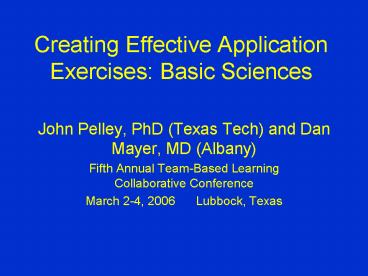Creating Effective Application Exercises: Basic Sciences - PowerPoint PPT Presentation
1 / 16
Title:
Creating Effective Application Exercises: Basic Sciences
Description:
Group Exercise #2. Evaluating the quality of the answers. ... Pancreatitis is a disease characterized by sudden onset of severe abdominal pain. ... – PowerPoint PPT presentation
Number of Views:44
Avg rating:3.0/5.0
Title: Creating Effective Application Exercises: Basic Sciences
1
Creating Effective Application Exercises Basic
Sciences
- John Pelley, PhD (Texas Tech) and Dan Mayer, MD
(Albany) - Fifth Annual Team-Based LearningCollaborative
Conference - March 2-4, 2006 Lubbock, Texas
2
Three Part Agenda
- General procedure Getting organized helpful
content in handout (15 min) - Group Exercises Evaluating question
construction (40 min) - Evaluation of presentation (5 min)
- Break and Posters 3pm to 330pm
3
Memorization vs. HOTS
- Memorization
- Recall
- Higher Order Thinking Skills (examples in
handout Writing Learning Objectives, pg 8) - Analysis (organization, indexing, grouping)
- Comparison (similarities, differences)
- Inference (deduction, cause-and-effect)
- Evaluation (predict, prescribe)
- HOTS used in clinical problem solving
4
Fundamentals For TBL Exercises
- Review from TBL101
- Problem oriented learning requires a specific
decision. - A decision requires a rationalea guess is not a
rationale! - Types of rationales (prompted by lead-in)
- Similarities, differences
- groupings/categories
- cause-and-effect relationships
5
Designing A TBL Exercise
- Start at the end the application exercise
- Prevents irrelevant RAT questions
- HOTS questions are essential
- One case vs. several cases time factor
- Step 1 (in handout, page 1)
- Too few is better than too many
- Three application question sets per hour
- 2-3 hour time blocks total
- 50 of time in application exercise
6
Sample Case Application Question
- See also handout (page 2)
- Question on next slide
- Required concepts are underlined
- All concepts in the question should be useful in
reaching the correct answer. - All answer choices are rational alternatives
(NBME Item Writers Guide)
7
- A 74 year old female has come to your office
suffering from hyperventilation, malaise,
dizziness, and muscle pains. She was diagnosed
with Type 2 diabetes at the age of 50 and has
managed her disease successfully with diet,
exercise, and hypoglycemic agents. She was
initially put on a hypoglycemic agent called an
oral sulfonylurea (chlorpropamide), but recently
was switched to metformin which is better
tolerated in the elderly. Her blood pH is 7.2 and
her serum lactate is 10X normal levels. Her
creatinine clearance and serum creatinine
concentrations indicate diminished renal
function.
8
Long Answer Choices
- This patient has a blood pH of 7.2 because
- ketones from excess fat mobilization are making
her blood acidic. - increased glycolysis and reduced TCA cycle
activity leading to excess lactate formation. - hypoxia resulting from inhibition of electron
transport is creating excess carbon dioxide. - increased blood sugar increasing glycolysis and
lactate production in red blood cells.
9
Or, Short Answer Choices
- Metformin action in the production of lactic
acidosis is most analogous to which of the
following? - Fluoride
- Pentachlorophenol
- Cyclic AMP
- Oligomycin
10
Barriers
- You dont know everything about the clinical
aspectsor, - You dont know how to integrate other disciplines
(see handout page 7, Resources for Application
Level Questions also TBL Collaborative). - Hard to find people that can help.
- Time consuming to look things upcan you trust
the internet?
11
Group Exercise 1
- Evaluating the quality of lead-ins (5-7 minutes
group, 10 minutes discussion). - Greatest opportunity for dialogue and problem
solving? - Look for integrative knowledge vs. memorized
knowledge
12
Group Exercise 2
- Evaluating the quality of the answers. (5-7
minutes group, 10 minutes discussion) - Lead in Which of the following is the best way
to correct her elevated pulse rate? - Greatest problem solving challenge?
- Emphasis on HOTS rather than memorization
13
Core Knowledge RATs and Learning Objectives
- Steps 2 and 3 in handout (page 1)
- RATs can have HOTSor not.
- RATs should be relevant derived from
- application exercise answer choices
- patient data in case vignette
- RATs are not comprehensivebut objectives are!
- Objectives should be relevant derived from RAT.
14
Two part application exercisePathophysiology and
EBM
- Part 1 calculation problem
- A study is done to look for the best diagnostic
test to detect pancreatitis. The study is done
on 2400 patients, of whom 950 have pancreatitis
as determined by a Gold Standard test. The tests
are lipase, amylase and trypsinogen. The numbers
of positive tests for each group are listed
below. - Test Disease present Disease absent
- (n 950)
- Trypsinogen 941 1204
- Lipase 817 1436
- Amylase (Beckman) 903 1291
- Calculate the sensitivity, specificity, and
likelihood ratios for each of these tests.
15
Part 2
- Your patient comes into the ED with abdominal
pain, which is consistent with pancreatitis, but
also with other diseases of the abdomen.
Pancreatitis is a disease characterized by sudden
onset of severe abdominal pain. These episodes
must be treated properly in order to prevent
complications. You desire to make a rapid and
accurate diagnosis that will distinguish acute
pancreatitis from other illnesses. Which test is
the best choice in this setting? - Test Cost Turn around time
- Trypsinogen 150.00 24 hours
- Lipase 30.00 1 hour
- Amylase (Beckman) 20.00 0.5 hours
- Treat the patient without doing any tests.
16
Summary
- TBL exercises are most effective if designed with
the application exercise first. - Higher order thinking skills are always
accompanied by a rationale. - NBME templates and question resources are
time-savers can be adapted.































